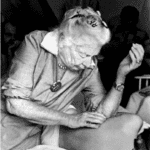
Craniosacral Massage:
Craniosacral Massage is about using extremely light pressure on the cranial, spine, and sacral bones to support the nervous system and restore cerebrospinal fluid balance. Practitioners are taught to “listen” for imbalances in the craniosacral rhythm, rather than only the skeletal system. It is also about finding stillness and inducing deep relaxation. Sessions are believed to restore feelings of balance and peace.
The beginning of the craniosacral technique began with William Garner Sutherland, who at the time was at The American School of Osteopathy in 1899. While studying cranial bones, the common school of thought was that the bones are somewhat flexible for infants, but in adults, the plates become fused with no more movement. Sutherland’s curiosity was provoked by observing the shape of bones like the temporal bone (the plate by the ears and jaw hinge), which appeared structured to support subtle movement. He also described its shape as being like the gills of a fish – designed for circulating air and fluid.
As his career continued, Sutherland emphasized the principle that breath, spinal fluid, and connective tissue had more to do with biomechanics than external factors. Through extremely gentle manipulations to the cranial area, he maintained that shifting the internal balance of spinal fluid was more beneficial than changing posture, exercises, or other techniques. With just a handful of practitioners carrying on his legacy, the theory stayed fringe until a school opened in the 1970s, later popularized in the 1980s–1990s by Dr. John Upledger.
Today, Craniosacral Therapy can be found in numerous spas, as it has benefited from being marketed to reduce wrinkles, puffiness, and inflammation around the face — much like gua sha and lymphatic massage. Even Massage Envy is marketing “craniosacral” services. However, these things shouldn’t be confused.
A real Craniosacral Massage certification (through Upledger Institute or Biodynamic) usually requires 2 to 3 years of intensive training. A lymphatic massage credential can be obtained in a weekend workshop. While the benefits of Craniosacral Therapy are intriguing, most spas are probably offering a “relaxation head or face massage” that they are calling “craniosacral.” Someone truly licensed in craniosacral therapy will have a certification listed or can provide their school of certification (different than a massage school) if asked.
Here is a directory of certified Craniosacral Massage professionals.
Somatic Movement Practices:
Some Somatic Movement Practices are very common, and others are obscure. Yoga, Qigong (not Qui-On), and Dance/Movement Therapy are the better recognized ones. However, with these practices, it depends more on how the movement is conducted and how intentional it is in addressing something like trauma or an emotional component. A typical Vinyasa Flow yoga class would not be considered somatic, but a Yin yoga class or trauma-informed yoga might be.
Two types of movement that are considered fully somatic are the Feldenkrais Method and the Trager Approach. The Feldenkrais Method centers on gentle exercises and awareness practices that use gravity, momentum, and subtle adjustments to restore easier movement. Some positions in Feldenkrais can make the person feel almost “weightless” and create a floating sensation by working with gravity. It can be done in large groups or one-on-one with an instructor. I have tried a Feldenkrais session and felt a sort of zero-gravity sensation like “jumping on the moon” in some of the exercises, that is difficult to describe.
The Trager Approach is more like a massage with light movement guided by a practitioner. The goal is to reset imbalanced patterns back to a more youthful, tension-free way of moving. It encourages loose, wave-like patterns that send signals of safety and relaxation through the nervous system. It’s guided by questioning the client on areas of physical tension connected to emotional stress. I have also tried a couple of Trager sessions where the practitioner had me make wave motions while standing, then gently rocked my arms, legs, feet, and head while I was on the table. For me, it was very relaxing and for a time, I did it myself at home.
For many, basic exercise is one of the best ways to reduce stress or “clear your head” after an emotional situation. Almost any form of movement exercise, even running, can be considered “somatic” if done with an intentional mindset. To make a jog “somatic” one would pay attention to breath and sensations in the body in connection to emotional states. There are podcasts that guide “meditative running” and that would count.
A Somatic Healing experience can be something very niche that takes extensive training to conduct, or it can be as simple as taking some deep breaths alone or going for a run. When signing up for any service that says “somatic,” it can be difficult to tell how the label is being used and if the service really is somatic.
The best approach is to ask: “What makes this a somatic experience?” If the provider can’t answer along the lines of “it’s a physical practice that is designed to release emotions or improve mood,” they probably need to read this newsletter. 😉


